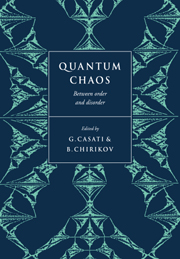Book contents
- Frontmatter
- Contents
- Preface
- Acknowledgments
- Introduction
- Part One Classical chaos and quantum localization
- Stochastic behaviour of a quantum pendulum under a periodic perturbation
- Quantum dynamics of a nonintegrable system
- Excitation of molecular rotation by periodic microwave pulses. A testing ground for Anderson localization
- Localization of diffusive excitation in multi-level systems
- Classical and quantum chaos for a kicked top
- Self-similarity in quantum dynamics
- Time irreversibility of classically chaotic quantum dynamics
- Effect of noise on time-dependent quantum chaos
- Dynamical localization, dissipation and noise
- Maximum entropy models and quantum transmssion in disordered systems
- Solid state “atoms” in intense oscillating fields
- Part Two Atoms in strong fields
- Part Three Semiclassical approximations
- Part Four Level statistics and random matrix theory
- Index
Classical and quantum chaos for a kicked top
Published online by Cambridge University Press: 07 May 2010
- Frontmatter
- Contents
- Preface
- Acknowledgments
- Introduction
- Part One Classical chaos and quantum localization
- Stochastic behaviour of a quantum pendulum under a periodic perturbation
- Quantum dynamics of a nonintegrable system
- Excitation of molecular rotation by periodic microwave pulses. A testing ground for Anderson localization
- Localization of diffusive excitation in multi-level systems
- Classical and quantum chaos for a kicked top
- Self-similarity in quantum dynamics
- Time irreversibility of classically chaotic quantum dynamics
- Effect of noise on time-dependent quantum chaos
- Dynamical localization, dissipation and noise
- Maximum entropy models and quantum transmssion in disordered systems
- Solid state “atoms” in intense oscillating fields
- Part Two Atoms in strong fields
- Part Three Semiclassical approximations
- Part Four Level statistics and random matrix theory
- Index
Summary
We discuss a top undergoing constant precession around a magnetic field and suffering a periodic sequence of impulsive nonlinear kicks. The squared angular momentum being a constant of the motion the quantum dynamics takes place in a finite dimensional Hilbert space. We find a distinction between regular and irregular behavior for times exceeding the quantum mechanical quasiperiod at which classical behavior, whether chaotic or regular, has died out in quantum means. The degree of level repulsion depends on whether or not the top is endowed with a generalized time reversal invariance.
Introduction
The quantum treatment of systems capable of chaotic motion in the classical limit is interesting for several reasons. First, there is the desire to see how the classical distinguishability between regular and chaotic motion gradually arises as the system is turned more and more classical by changing a suitable parameter. By a controlled increase of quantum mechanical time scales such as wave packet spreading times or inverse level spacings, for instance, one would like to study the growth of the life time of effectively chaotic evolution of suitable observables.
Perhaps an even greater incentive for quantum mechanical investigations lies in the question whether quantum chaos can be more than a mere transient mimicry of classical chaos. If so, we need intrinsically quantum mechanical criteria to distinguish regular an irregular behavior; the relation of such quantum criteria to the traditional ones for classical chaos would have to be clarified.
- Type
- Chapter
- Information
- Quantum ChaosBetween Order and Disorder, pp. 111 - 126Publisher: Cambridge University PressPrint publication year: 1995

